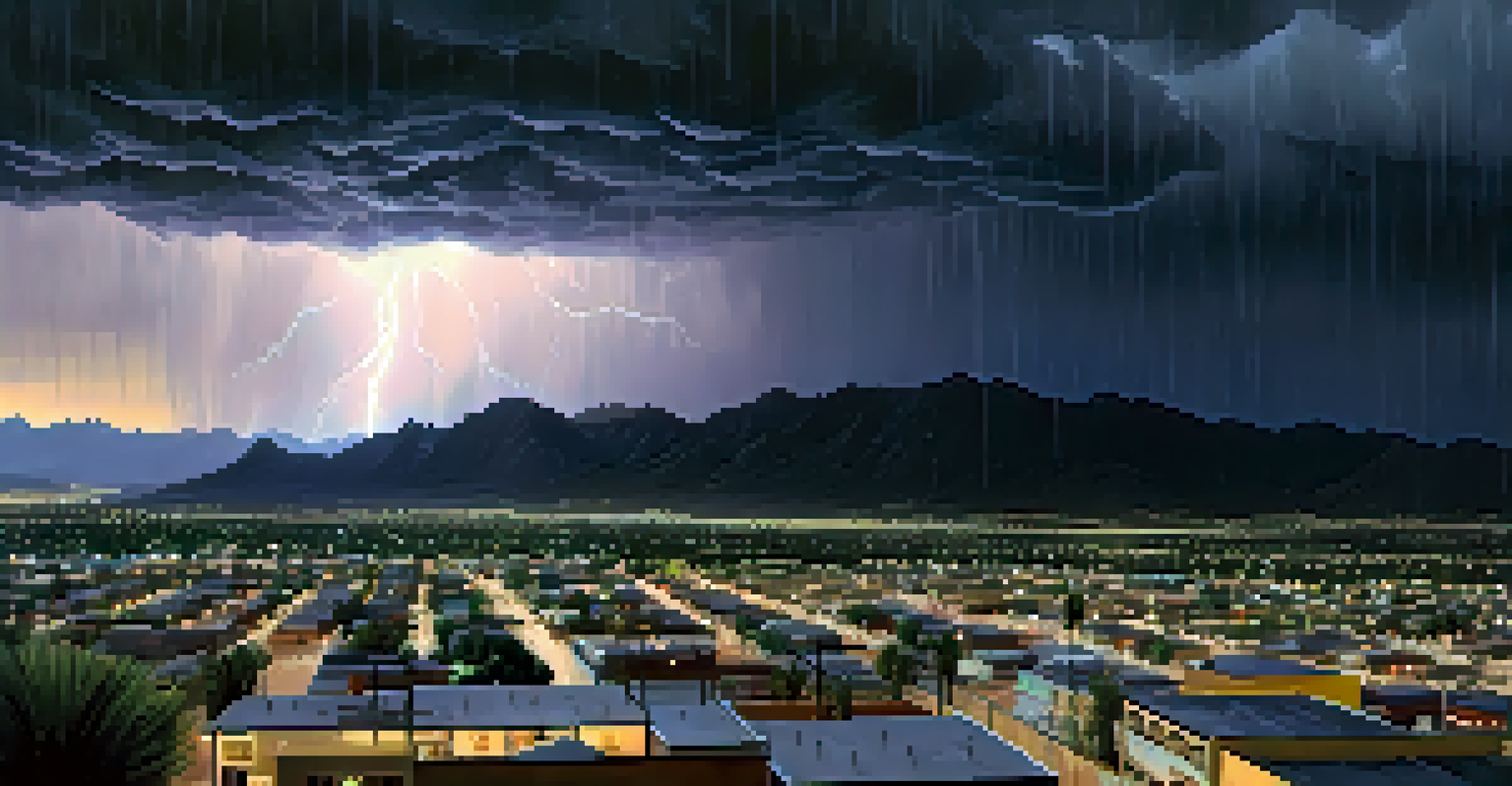Tucson's Monsoon Season: Weather Patterns and Community Impact

What is Tucson's Monsoon Season and When Does it Occur?
Tucson's monsoon season typically runs from late June to mid-September. This unique weather phenomenon brings significant changes in temperature and humidity, making it stand out from the dry desert climate. The arrival of the monsoon is marked by the cooling of temperatures and the onset of intense rainstorms, often accompanied by thunder and lightning.
In the desert, the rains are like a miracle, transforming the landscape and breathing life into the barren earth.
During this period, the atmosphere becomes charged with moisture, creating the perfect conditions for storms. These storms can vary in intensity, from light rain showers to torrential downpours. Understanding this season is vital for both residents and visitors as it influences daily life in the city.
The monsoon not only impacts weather patterns but also enriches the natural landscape, painting Tucson in vibrant greens after the rains. This transformation is a reminder of nature's resilience and the cyclical patterns that define our environment.
The Science Behind Monsoon Weather Patterns
Monsoon weather patterns in Tucson are driven primarily by changes in wind patterns and temperature differentials. As the desert heats up, it creates low-pressure areas that draw in moist air from the Gulf of California and the Pacific Ocean. This influx of humidity is what ultimately leads to the formation of storm clouds and subsequent rainfall.

The storms can develop rapidly, often catching people off guard. It's not uncommon for a sunny day to quickly turn into a dramatic lightning show with heavy rainfall. Understanding these patterns helps residents prepare for sudden weather changes, ensuring safety during storm events.
Monsoon Season Transforms Tucson
Tucson's monsoon season, occurring from late June to mid-September, brings vital rainfall that rejuvenates the desert landscape and supports local ecosystems.
Moreover, these weather patterns are crucial for replenishing groundwater supplies and supporting local flora and fauna. The seasonal rains play a vital role in maintaining the ecological balance and ensuring that the desert blooms with life during and after the monsoon.
Impact of Monsoon on Tucson's Ecosystem
The arrival of the monsoon season brings a refreshing change to Tucson's arid ecosystem. The heavy rains transform the desert landscape, triggering a burst of growth among native plants and wildflowers. This seasonal phenomenon not only beautifies the surroundings but also supports local wildlife that relies on these plants for food and shelter.
The monsoon is not just a season; it's a celebration of life that connects us to the rhythms of nature.
Furthermore, the monsoon rains help to refill rivers, streams, and other water bodies in the region. This is essential for maintaining biodiversity and ensuring that both plants and animals can thrive in the desert environment. Consequently, the monsoon season is a critical time for the ecosystem to rejuvenate and sustain life.
The impact of the monsoon on Tucson's ecosystem is a testament to the interconnectedness of weather patterns and natural habitats. It highlights how seasonal changes can significantly enhance the vibrancy of the desert landscape, making it an essential focus for conservation efforts.
Community Preparedness for Monsoon Season
Tucson residents take monsoon season seriously, recognizing the importance of preparedness. Local authorities often run awareness campaigns to educate citizens about potential hazards, such as flash floods and debris flows. These efforts are crucial for ensuring that everyone knows how to respond during severe weather events.
Community preparedness involves creating emergency plans, securing homes, and knowing evacuation routes. Many neighborhoods come together to organize training sessions, ensuring that residents understand how to stay safe during storms. This collective effort strengthens community bonds and fosters a sense of security.
Community Readiness is Key
Residents of Tucson actively prepare for monsoon season by creating emergency plans and participating in awareness campaigns to ensure safety during severe weather.
Moreover, local organizations often offer resources and assistance to vulnerable populations, ensuring that everyone is equipped to handle the challenges posed by the monsoon. This spirit of solidarity is a hallmark of Tucson's community, showcasing how residents look out for one another during this dynamic season.
Economic Effects of Monsoon Season on Tucson
The monsoon season has significant economic implications for Tucson, impacting various industries. Agriculture, for instance, benefits immensely from the increased rainfall, providing essential irrigation for crops. Farmers eagerly await the monsoon, as it can determine the success of their harvests and influence local food supply chains.
Additionally, the tourism sector experiences fluctuations during this season. Some visitors are drawn to Tucson's unique monsoon storms, seeking to witness the dramatic weather firsthand. Conversely, heavy rains can deter others from traveling, affecting local businesses that rely on tourist foot traffic.
Overall, while the monsoon brings challenges, it also presents opportunities for growth and revitalization in Tucson's economy. Balancing these factors is essential for local businesses and community leaders as they navigate the seasonal changes.
Cultural Significance of Tucson's Monsoon Season
The monsoon season holds a special place in Tucson's cultural identity, influencing art, literature, and community events. Many local artists draw inspiration from the dramatic weather, capturing the beauty and intensity of the storms in their work. This seasonal transformation is often celebrated in various forms of expression, from painting to poetry.
Moreover, community festivals often coincide with the monsoon season, celebrating the life-giving rains that sustain the desert ecosystem. These events foster a sense of unity among residents and provide an opportunity to honor traditional practices that revolve around the changing seasons.
Economic Impact of Monsoons
The monsoon season significantly affects Tucson's economy, benefiting agriculture while also presenting challenges for the tourism industry.
The cultural significance of the monsoon extends beyond mere celebration; it reflects the deep connection between Tucson's inhabitants and their environment. This bond is a reminder of the importance of respecting nature's rhythms and the role it plays in shaping the community's identity.
Looking Ahead: The Future of Tucson's Monsoon Season
As climate change continues to impact weather patterns globally, Tucson's monsoon season may see changes in its intensity and frequency. Scientists are studying these trends to understand how shifting conditions could alter the landscape and community dynamics in the future. Awareness and preparedness will become increasingly important as residents adapt to these changes.
Local authorities are also focusing on sustainable practices to manage stormwater and mitigate potential flooding risks. Innovations in green infrastructure and community planning are essential to ensure that Tucson can thrive despite the challenges posed by climate change.

Ultimately, the future of Tucson's monsoon season is a topic of concern and intrigue. By fostering a culture of preparedness and sustainability, the community can navigate the uncertainties ahead while continuing to embrace the beauty and vitality that the monsoon brings.